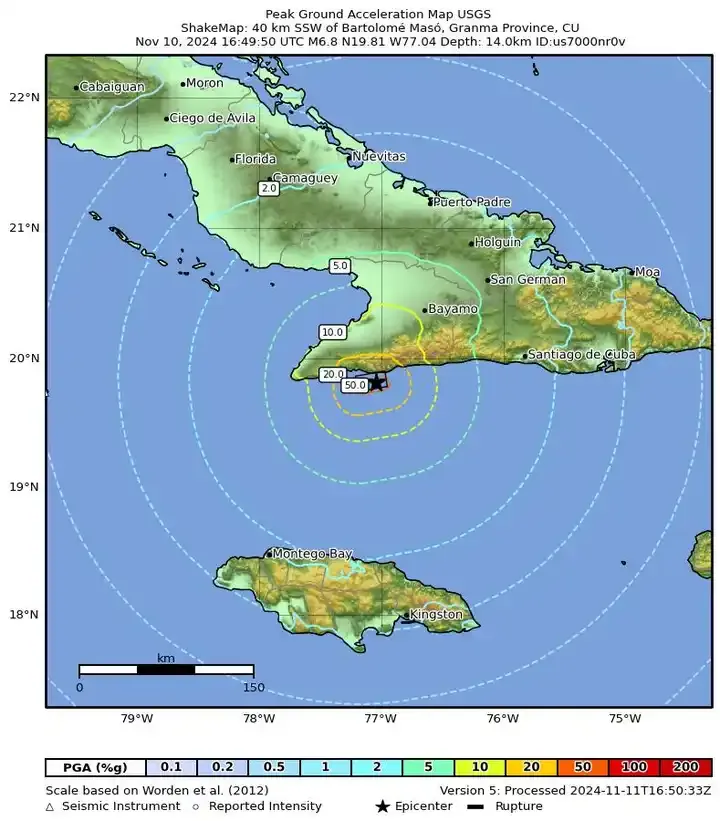
Los domingos me levanto muy temprano para resolver cuestiones que no puedo hacer durante la semana y, cuánto más temprano empiezo, más tiempo tengo para descansar. Bueno, este domingo en particular terminé de resolver todo después de las dos de la tarde y tuve que ir a casa de una amiga después. Al llegar, me dijo alarmada: ¿Te has enterado del desastre que ha provococado el terremoto que ha ocurrido en oriente? Inmediatamente le respondí: ¿Hubo un terremoto en oriente? Con todos los músculos de mi cara contraídos. Realmente no había tenido tiempo ni de ver más allá de los mensajes que tenía en el celular. Lo segundo que pensé fue que hacía poco un ciclón había hecho de las suyas por allí y ahora esto, y en que en Cuba últimamente no dejan de ocurrir cosas malas, unas tras otras.
On Sundays I get up very early to resolve issues that I can't do during the week and the earlier I start, the more time I have to rest. Well, this particular Sunday I finished resolving everything after 2pm and had to go to a friend's house afterwards. When I arrived, she said to me in alarm: Did you hear about the disaster caused by the earthquake that happened in the east? I immediately answered her: There was an earthquake in the east? With all the muscles in my face contracted. I hadn't really had time to look beyond the messages I had on my cell phone. The second thing I thought was that a cyclone had recently done its thing over there and now this, and that bad things keep happening in Cuba lately, one after the other.
Después, mi amiga siguió comentando: Y hay hasta alerta de tsunami. Bueno, ya ahí vi la cosa un poco sospechosa, pero no hice ningún comentario al respecto; solo me dije por dentro que eso era bastante poco probable.
Then, my friend continued commenting: And there is even a tsunami warning. Well, there I saw the thing a bit suspicious, but I didn't make any comment about it; I just said to myself inside that it was quite unlikely.
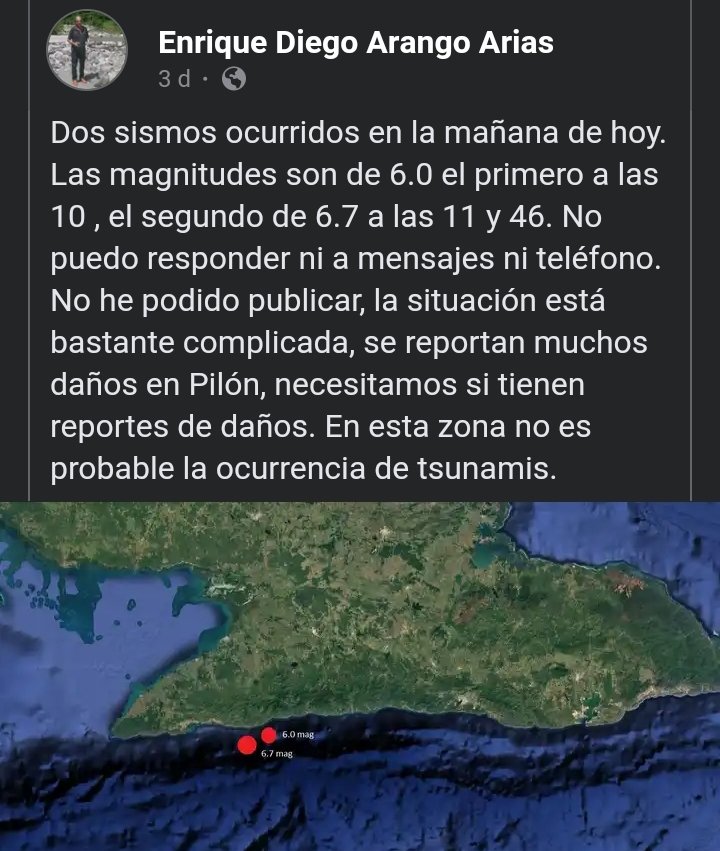
Two earthquakes occurred this morning. The magnitudes are 6.0 the first one at 10 o'clock and the second one 6.7 at 11:46 a.m. I can't respond to messages or telephone. I have not been able to publish, the situation is quite complicated, many damages are reported in Pilon, we need if you can report damages. Tsunamis are not likely to occur in this area.
En la zona oriental de Cuba no es la primera vez que ocurre un terremoto y, muy al contrario de lo que dicen las personas en la calle, este no fue el más intenso. Ahora bien, ¿por qué se produjo este terremoto? Te lo voy a explicar, sin utilizar términos geológicos complicados. Simplemente, fue causado por lo que en geología se conoce como movimientos tectónicos. En este caso, fue de una de las fallas de la llamada Zona de Falla Septentrional-Oriente que se movió de izquierda a derecha debido a la interacción de las placas tectónicas en esa región en particular. Aunque esta es la explicación más aceptada que podría darle a cualquier persona, los terremotos ocurren por una variedad de factores. Además, la sismicidad de esta región en particular, hace que sea más propensa a experimentar terremotos.
It is not the first time that an earthquake has occurred in the eastern part of Cuba and, contrary to what people in the street say, this was not the most intense one. Now, why did this earthquake occur? I am going to explain it to you, without using complicated geological terms. Simply, it was caused by what in geology is known as tectonic movements. In this case, it was from one of the faults of the so-called North-East Fault Zone that moved from left to right due to the interaction of the tectonic plates in that particular region. Although this is the most accepted explanation that I could give anyone, earthquakes occur due to a variety of factors. In addition, the seismicity of this particular region makes it more prone to experiencing earthquakes.
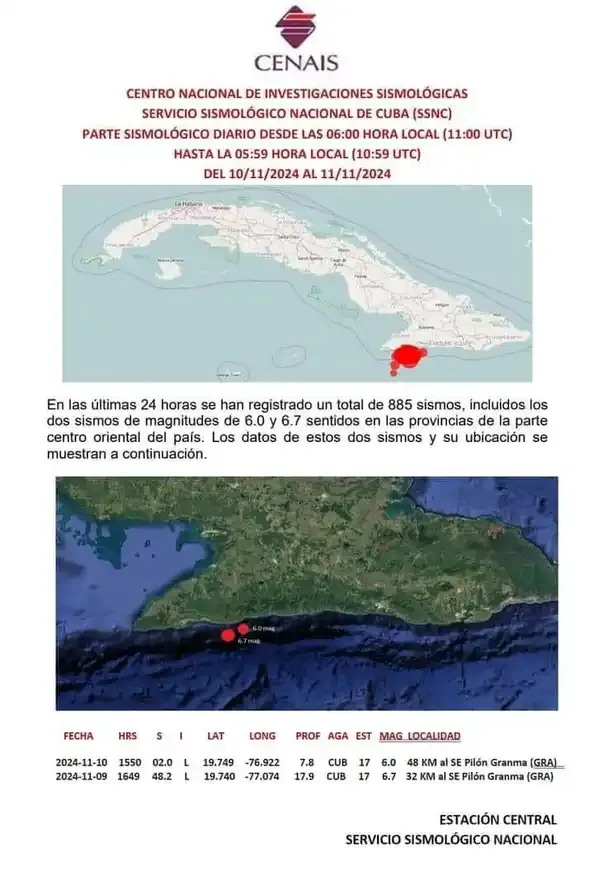
A total of 885 earthquakes have been recorded in the last 24 hours, including two of magnitude 6.0 and 6.7 felt in the central part of the country.
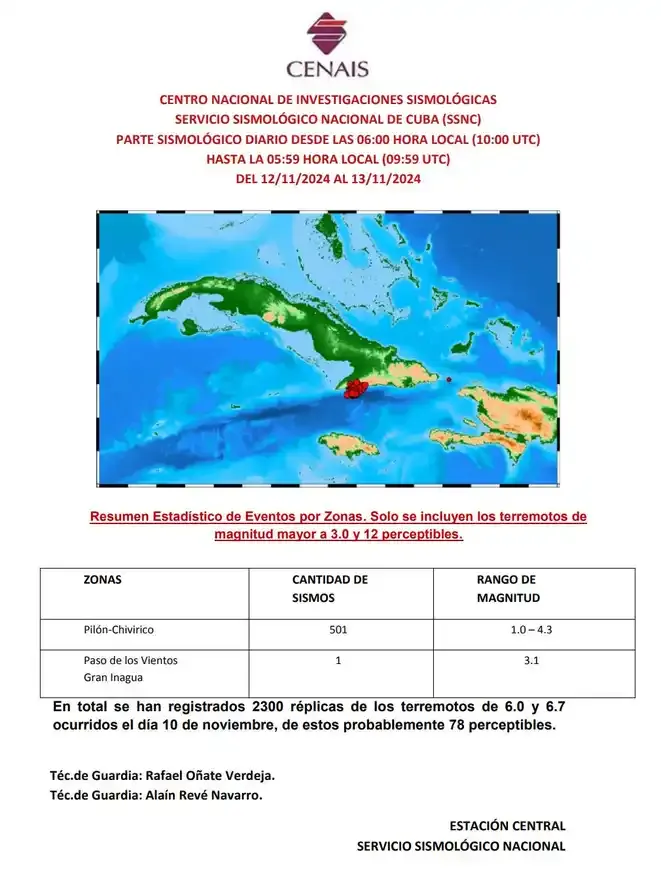
A total of 2300 aftershocks have been reported from the November 10 earthquakes, of which probably 78 were perceptible.
Ahora, en cuanto a la posibilidad de que se produzca un tsunami en las costas de esta región, el CENAIS (Centro Nacional de Investigaciones Sismológicas. Servicio Sismológico Nacional de Cuba (SSNC)) explicó que no es posible. Vi una que otra explicación en Facebook sobre este tema, demasiado extensas, lo que podrían disociar a cualquiera y que creo que solo la entenderían especialistas en la materia. Te lo explico de forma tal que puedas entender. Es muy improbable que se produzca un tsunami en esta región, porque las placas en esta área se mueven una al lado de la otra (de forma horizontal), esto como debes imaginar, produce cierta fricción y tensión entre ellas. La única forma que tienen de liberar la energía producida por la fricción y tensión es mediante terremotos que provocan una ruptura abrupta en la superficie de las placas, no bajo el mar, por lo tanto, no pueden originarse tsunamis, ya que para que se diera el mismo tendría que haber un movimiento vertical significativo en el fondo marino, cosa que ningún cubano desea. 👈 Esta es la forma más fácil de entender, pero existen muchas más variables a considerar para que ocurra un tsunamis, por eso te invito a leer este artículo donde entrevistan al Ingeniero en Geología Eberto Hernández Suró, sismólogo con más de tres décadas dedicados al estudio de la actividad sísmica en Cuba. Su explicación es muy detallada, amplia y todo el mundo la puede entender. Es el artículo que más me ha gustado de todas las informaciones que he leído sobre el tema hasta el momento: http://www.cubadebate.cu/especiales/2024/11/12/en-cuba-se-estima-que-un-terremoto-significativo-ocurra-cada-80-a-90-anos/
Now, as for the possibility of a tsunami off the coast of this region, the CENAIS (Centro Nacional de Investigaciones Sismológicas. Servicio Sismológico Nacional de Cuba (SSNC)) explained that it is not possible. I saw some explanations on Facebook on this subject, too extensive, which could dissociate anyone and I think that only specialists in the subject would understand it. I will explain it in a way that you can understand. It is very unlikely that a tsunami will occur in this region, because the plates in this area move side by side (horizontally), this as you can imagine, produces some friction and tension between them. The only way to release the energy produced by the friction and tension is through earthquakes that cause an abrupt rupture on the surface of the plates, not under the sea, therefore, tsunamis cannot be originated, since in order to cause a tsunami there would have to be a significant vertical movement on the seabed, something that no Cuban wants. This is the easiest way to understand, but there are many more variables to consider for a tsunami to occur, so I invite you to read this article where they interview the Geological Engineer Eberto Hernandez Suró, seismologist with more than three decades dedicated to the study of seismic activity in Cuba. His explanation is very detailed, comprehensive and everyone can understand it. It is the article that I have liked the most of all the information I have read on the subject so far: http://www.cubadebate.cu/especiales/2024/11/12/en-cuba-se-estima-que-un-terremoto-significativo-ocurra-cada-80-a-90-anos/
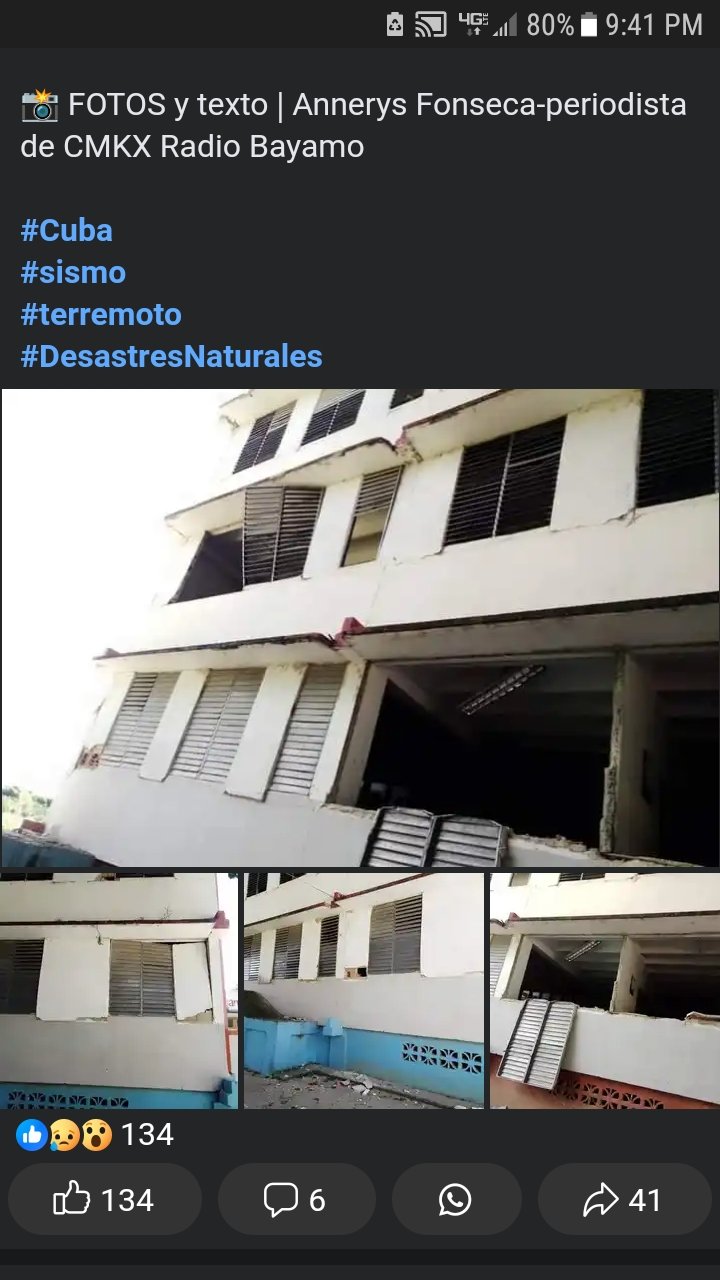
Some of the damages that had the greatest impact on the beautiful province of Granma.
Translated with DeepL.com (free version)


**
Sending Love and Ecency Vote!
 Follow Eceny's curation trail to earn better APR on your own HP. : )
Follow Eceny's curation trail to earn better APR on your own HP. : )
Thank you 🤗